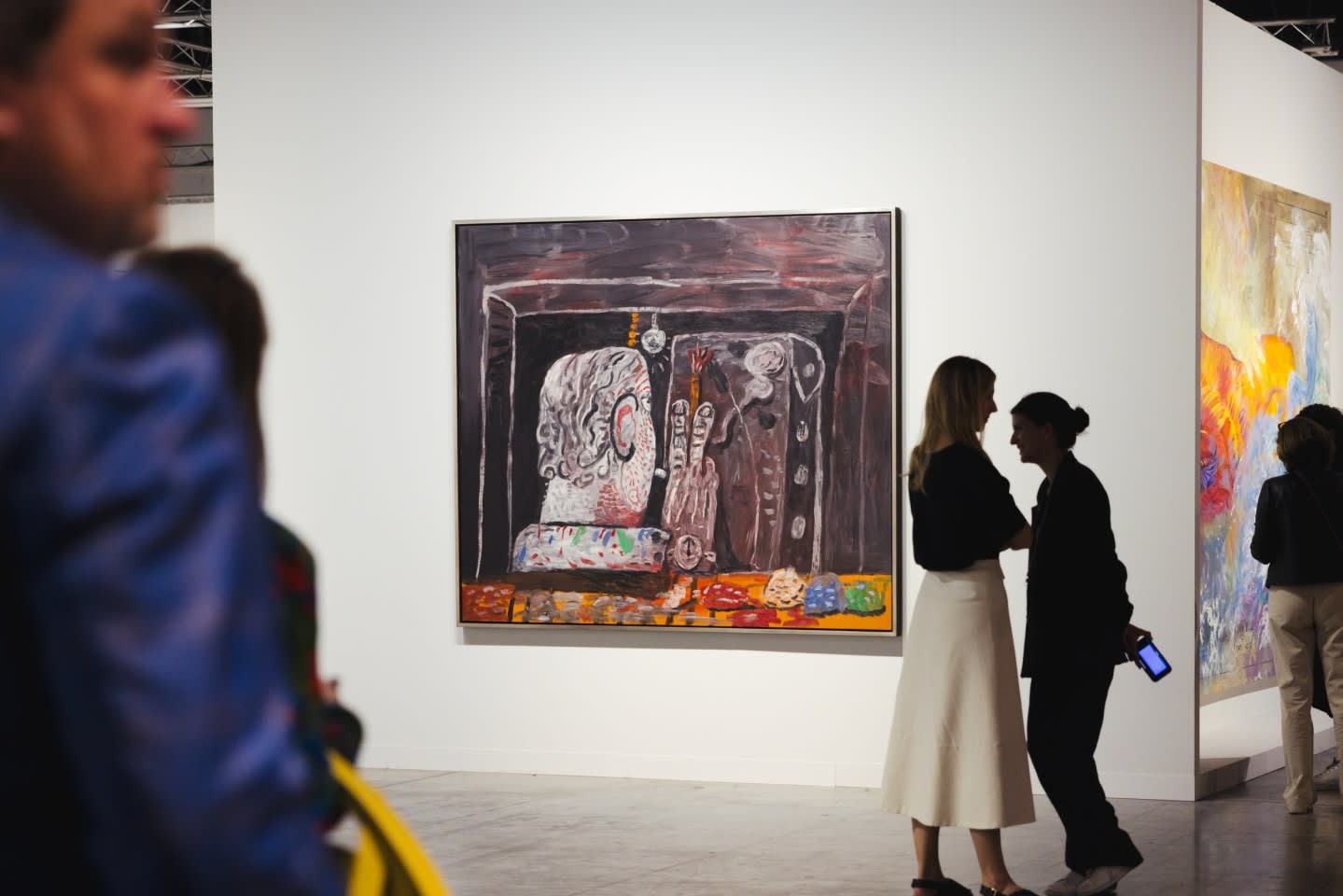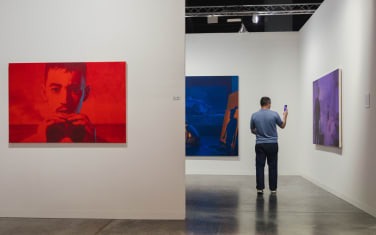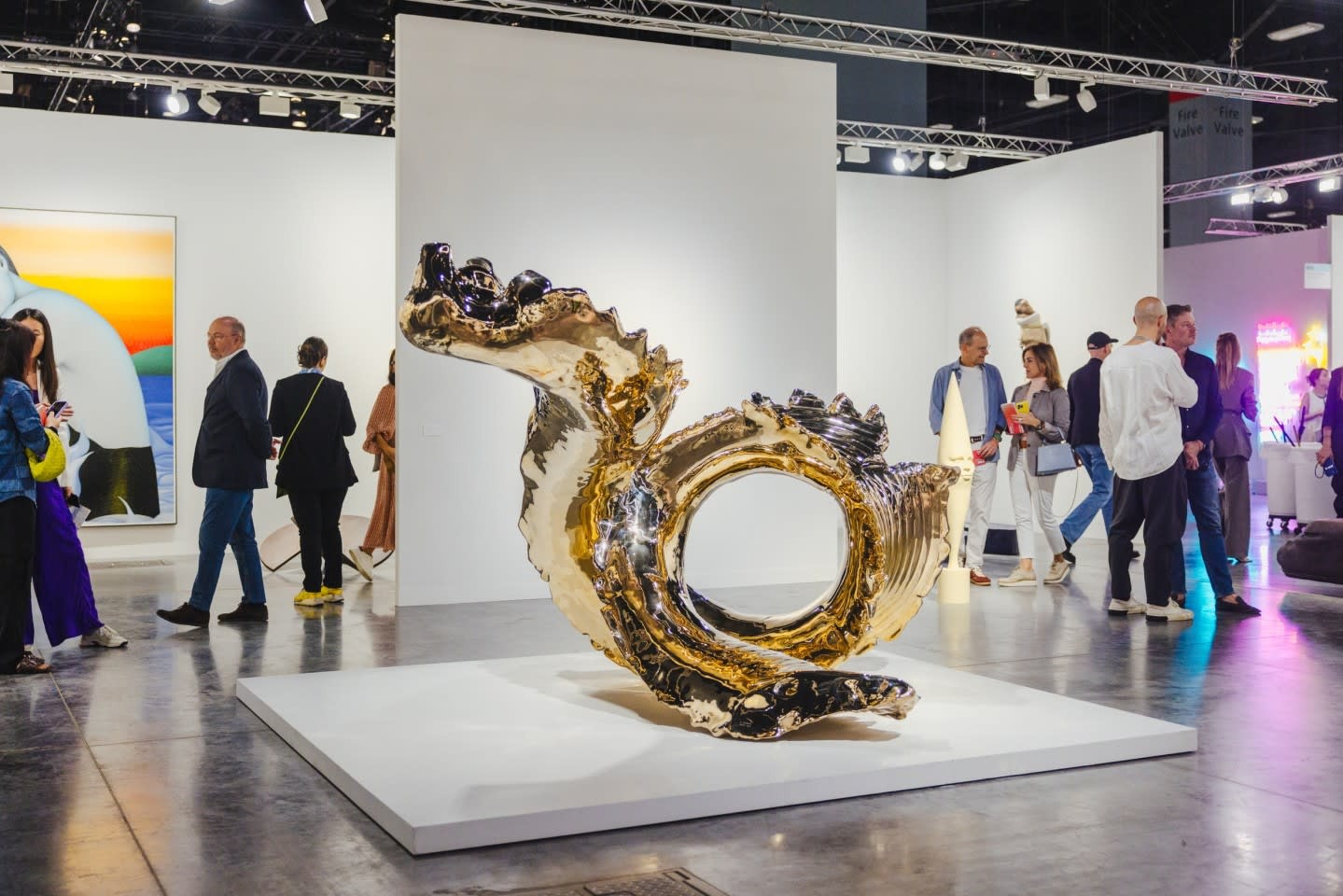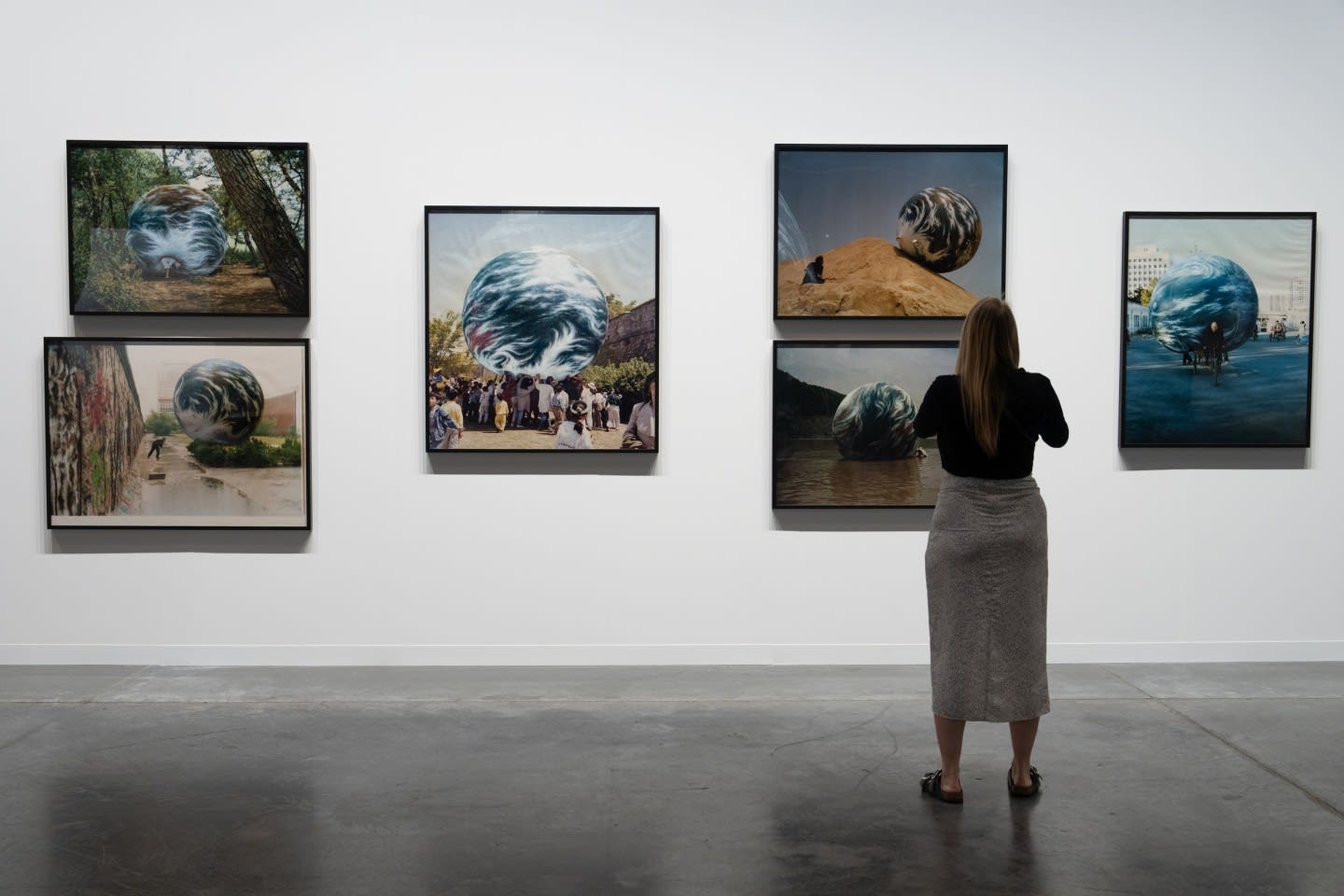That the remit of major art fairs has broadened to much more than just, well, selling art, is a fact that will not surprise most that have attended one – or simply been in town when one passes through – in recent years. While once they were selling artworks, over the past decade or so, their function has morphed. “Fairs, and especially our fairs, are no longer pure commercial affairs,” concurs Vincenzo de Bellis, Art Basel’s Director of Fairs and Exhibition Platforms, responsible for overseeing the itinerant juggernaut’s annual showcases in Basel, Hong Kong, Paris and Miami Beach. Granted, that’s not to say that money-making is no longer their central purpose – “after all, all the artists live from the commercial success of their works,” Vincenzo continues, “but on the other hand, we know that the fairs have basically become what the biennials used to be many years ago — the moment where you see what’s, and where platforms are given that catalyse people all around the world.”
Few fairs exemplify the evolved status of today’s art fair quite like Art Basel Miami Beach, the gravitational centre of the city’s annual art week, which closed this Sunday. America’s most prestigious art fair, it has earned a reputation as a climax in the Western Hemisphere’s art calendar. There are numerous logistical and historical reasons for that: for one thing, not only does its status as the eminent American art fair position it as a forum for the US art market, the world’s most developed in terms of sales figures, but it’s also a crucial point of access to the booming Latin American art market for galleries and collectors alike.
There’s also the general atmosphere of the fair. Put plainly, Miami in December is a big vibe. Granted, that can be said for the city year-round, with its outsize number of top-tier institutions – such as the Pérez Art Museum, The Bass, the Rubell Museum – fair weather, beach culture and well-earned reputation for hedonism. The arrival of Miami Art Week, just a couple weeks out from the holiday season, seemingly turbocharges these attributes, lending it a festive atmosphere that feels unique among art fairs – not to mention one that encourages loose purse strings.

And this year, despite headlines warning of global economic downturn — collectors remained as keen to spend as ever, confirming the unfortunate truth that bust for the many often translates to boom for the few. ‘For us, the opening of Art Basel Miami Beach was a resounding affirmation of the American art market’s strength and resilience,” Marc Payot, President of globe-spanning blue-chip gallery Hauser & Wirth, says. “In the first hours of the fair, we welcomed a fantastic cross-section of seasoned collectors, curators, and museum colleagues, and sold the majority of the works in our first-day presentation.” “This year, despite the financial issues of higher interest rates and global political turmoil, people are looking for art to enhance their lives,” echoes Kamel Mennour, owner of Paris-based gallery Mennour. “Visitors come here to purchase more than most fairs we participate in.”
While deep-pocketed collectors continue to buy at pace, what they’re buying seems to correlate with what you’d expect in the current macroeconomic climate. Indeed, galleries across the fair reported a general trend towards works perceived as risk-averse, stable investments. Malik Al-Mahrouky, Partner at Mexico City-based gallery kurimanzutto, reported an “unexpected surge in the swift sale of higher-value pieces, including an Orozco and a Murillo,” indicating a tendency towards “the solidity and security offered by these prestigious artworks,” a sentiment echoed by London gallery Edel Assanti’s co-founder Jeremy Epstein: “We felt the opening days reflected the general market mood — less spontaneous, frenzied buying, and more measured engagement with artists who are receiving significant institutional attention.”

Indeed, such testaments seem to echo what many have observed as a conservative turn in culture at large – which, in fashion for example, has translated to houses offering safer, ‘wardrobe’ focussed collections and investment-worthy staples rather than more outré, fashion-forward visions. The situation in the art world, Vincenzo de Bellis argues, isn’t quite as clear cut. “In general, I think what we’ve experienced with visual art is that traditional media — which, to some extent, to many people, can be seen as very conservative — have probably been the most ‘used’, for lack of a better word, in recent years,” he notes, an observation that qualifies the dominance of painting, for example, across this year’s fair. “That’s the case for artists who were previously working in other media — I’ve known artists who were previously working with video and installations that were forced to do other things.”
But rather than an expectation to reflect – or cater to – a wider cultural conservatism, what has compelled a large number of artists to work with more conventional media has more to do with the physical limitations placed upon their practices over the past four years. “It has a lot to do with the pandemic – artists went back to their studios as, like for all of us, being present in communities wasn’t necessarily possible,” Vincenzo says. “As such, I can definitely say there’s been an increase in more traditional approaches to art. That said, in terms of the content of the work, I don’t think that’s the case.”
Indeed, while this year’s fair may generally have lacked in terms of flashy works with TikTok virality, there were a plethora of outstanding presentations, particularly from booths that focussed on sculpture and photography. Standouts included São Paulo gallery Galatea’s solo presentation of the work of Allan Weber, a Rio de Janeiro-born multidisciplinary artist whose photographic works offer poignant insights into his lived experiences of the city’s favelas, and whose burgeoning sculptural practice recontextualises baile funk posters and drug trafficking paraphernalia. Another Brazilian gallery that mounted a particularly arresting presentation was São Paulo-based, internationally renowned blue-chip gallery Mendes Wood DM, whose booth included a majestic coiled gold sculpture by Lynda Benglis alongside paintings and sculptures by buzzy French artist Pol Taburet that read like quasi-religious icons lifted from a fever dream. Elsewhere, Milanese gallery Lia Rumma presented a selection of arrestingly disconcerting large-scale photographs by Vanessa Beecroft, counterposed by Rineke Dijkstra’s tenderly awkward portraits of groups of teenagers at the Marian Goodman booth nearby, while contemplative sculptures by Rhea Dillon and Phoebe Collings-James filled a joint booth by Soft Opening and Arcadia Missa.

Where the fair’s most impactful work was to be found, though, was in a section that transcended – and almost subverted – the context in which it was shown. At the north end of the cavernous Miami Beach Convention Centre lay Meridians, an area dedicated to the presentation of works of a scale that exceed the physical limitations of the art fair booth that was initiated in 2019 under the purview of Magalí Arriola, curator of Mexico City’s Museo Tamayo. Her institutional background made itself strongly felt in the powerful curation of large-scale works that grappled with themes of nature – in the broadest sense – and our collective relationship to the concept in an ever-evolving landscape of identities. From Eric N. Mack’s suspended, painting-like mobile sculptures comprised of swatches of bright fabric – gently turning in the breeze generated by bodies moving about the space – to a gigantic deflating globe – the physical focal point of Seung-Tak Lee’s extensive photographic and performance series from 1990 commenting on post-industrialised Korea and the environmental cost of socioeconomic development – the works on show were imbued with the conceptual rigour you’d expect of a museum show. “That’s what makes Meridians so crucial,” Vincenzo says, “It’s something that expands the outreach of the fair and takes it beyond the purely commercial.”
If the figures are anything to go by, such attempts to broaden the reach of the fair seem to be working. This year’s edition of Art Basel Miami Beach drew a total of 79,000 visitors over its five-day run – and, granted, many won’t have turned up serious intentions of buying works, but rather to window shop, for the eclectic Conversations programme featuring the likes of Cuban-born artist Maria Magdalena Campos-Pons and Chance The Rapper, or just for the general ambience. That’s not just a good thing for the reputation of the fair, though. With the size of the culturally astute clientele that art fairs have always drawn on the up, they’re becoming increasingly attractive forums for players from outside the art world – particularly fashion brands.
Granted, fashion’s presence in the art world is hardly a new phenomenon – see: brand-associated foundations such as the Fondation Louis Vuitton in Paris and Milan’s legendary Fondazione Prada, as well as the slew of brand-sponsored museum galas, exhibitions and even curatorial positions at institutions worldwide. Still, in an art fair context, where sponsors from the worlds of finance and automotive have a long-since-familiar presence, the boom in their appearance is nonetheless conspicuous.

During this year’s edition of Art Basel Miami Beach, the fair itself played host to activations by Swiss sports and lifestyle brand On, who staged a pop-up ‘speakeasy’ for a running shoe created in collaboration with artist Pamela Rosenkranz; Louis Vuitton, who presented a series of its emblematic Capucines bags reinterpreted by starchitect Frank Gehry; and streetwear platform GOAT, who worked with artist Kandis Williams on the uniforms for this year’s fair attendants. And that’s not to mention the fashion-affiliated events that took place parallel to the fair, from SSENSE’s party with Marni to the staging of a wrestling match by Japanese women’s wrestling league Sukeban, outfitted by Olympia Le Tan and art directed by Isamaya Ffrench.
To look at it somewhat cynically, you could remark that staging a branded party or activation adjacent to an event renowned as a repository of extreme wealth is a no-brainer – if someone’s prepared to drop top dollar on a Noah Davis at the David Zwirner, getting them to part with $200 for a pair of trainers isn’t the hardest sell. There’s also the superior cultural cachet that the art world garners compared to the comparatively over-exposed fashion world, which brands are naturally keen to align themselves with. Still, Vincenzo de Bellis sees mutual benefit in the ever-increasing intersection of the two. “I’m incredibly interested in the way the fashion world is looking at the art world. There’s cross-pollination all over, and I think that interdisciplinarity is defining creativity now, and will continue to define it in the future,” he notes. “For example, I truly believe that Alessandro Michele, the former creative director of Gucci, is an artist — I wrote this publicly and I say it again, his fashion shows were visual art performances that used the fashion world as a way of being more pop, and brought art to a vast audience.” It’s this reach that he sees as an attractive asset in the mission to expand the reach of the art world – and by extension, art fairs. “I don’t know what other people think, but I think that the art world has room for being more popular, and if the fashion world helps the art world to become more mainstream and open itself up to more people, I’m all for it.”
Vincenzo’s openness to widening Art Basel’s infrastructure to include non-traditional players, approaches and audiences is telling of the new status that global art fairs have acquired in a wider cultural landscape. Granted, their commercial — corporate, even — nature remains firmly intact, and it would be remiss to imply that they’ve suddenly become open-to-all affairs unconditioned by socioeconomic elitism. Still, there’s nonetheless something to be said for how this commercial clout is being deployed to engage audiences that exist beyond the traditional purview of a notoriously insular space — a fact that encourages hope for an uptick in dynamic, diverse perspectives in the art world — and in worlds it’s increasingly overlapping with, at large.

Credits
Images courtesy Art Basel

